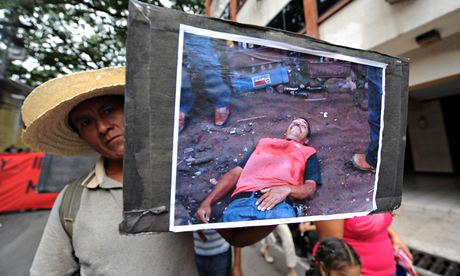Surge in deaths of environmental activists over past decade, report finds
Investigation by Global Witness reveals there were nearly three times as many deaths in 2012 than 10 years previously
The Guardian (UK) | 15 April 2014

Members of the Peasant
Unified Movement of Bajo Aguan, Honduras, carry mock coffins bearing
pictures of people killed in land conflict clashes. There were 109
activist deaths between 2002-13 in Honduras, making it the world's
second deadliest country for communities defending natural resources.
Photograph: Orlando Sierra/AFP/Getty Images
The killing of activists protecting land rights and the environment has surged over the past decade, with nearly three times as many deaths in 2012 than 10 years previously, a new report has found.
Deadly Environment,
an investigation by London-based Global Witness documents 147 recorded
deaths in 2012, compared to 51 in 2002. Between 2002 and 2013, at least
908 activists were killed in 35 countries – with only 10 convictions.
The death rate has risen in the past four years to an average of two
activists a week, according to the report, which also documents 17
forced disappearances, all of whom are presumed dead.
Deaths in
2013 are likely to be higher than the 95 documented to date, the
environmental rights organisation warned, with under-reporting and
difficulties verifying killings in isolated areas in a number of African
and Asian nations. Reports from countries including Central African
Republic, Zimbabwe, and Myanmar, where civil society groups are weak and
the regimes authoritarian, were not included in the Global Witness
count.
Brazil,
the report found, is the world's most deadly country for communities
defending natural resources, with 448 deaths between 2002 and 2013,
followed by 109 in Honduras
and Peru with 58. In Asia, the Philippines is the deadliest with 67,
followed by Thailand at 16. More than 80% of the recorded deaths were in
Latin and Central America.
There have been only 10 successful
prosecutions connected with the killings in Brazil over the past 12
years. Isolete Wichinieski, national coordinator of the Brazilian group
Commisão Pastoral da Terra, said: "what feeds the violence is the
impunity".
The investigation unearthed information on perpetrators
in just 294 of the 448 deaths, of which 54 were identified as police or
military units.
In Brazil, the Amazon is the main frontier and
most violent conflicts take place in newly deforested areas where
communities are first confronted by illegal loggers, closely followed by
cattle ranchers and soy bean farmers.
In Honduras, the second
most dangerous country, 93 peasant farmers in the fertile Bajo Aguan
region have been murdered since 2010 amid land conflicts with agribusinesses expanding African palms plantations that are traded globally on the lucrative carbon credits scheme.
But
the murder of Brazilian ecologists José Cláudio Ribeiro da Silva and
Maria do Espírito Santo in May 2011 suggests high-profile campaigners
are not immune from the violence. Two assassins in this case were
convicted.
 Laisa do Espirito Santo visits the graves of her sister Maria do
Espírito Santo da Silva and brother-in-law José Cláudio Ribeiro da
Silva, rainforest activists who were murdered in Nova Ipixuna, Para,
northern Brazil, on June 2011. Photograph: Evaristo Sa/AFP/Getty Images
Laisa do Espirito Santo visits the graves of her sister Maria do
Espírito Santo da Silva and brother-in-law José Cláudio Ribeiro da
Silva, rainforest activists who were murdered in Nova Ipixuna, Para,
northern Brazil, on June 2011. Photograph: Evaristo Sa/AFP/Getty Images
Oliver Courtney, senior campaigner at Global Witness, said: "There
can be few starker or more obvious symptoms of the global environmental
crisis than a dramatic upturn in killings of ordinary people defending
rights to their environment and livelihoods from corporate and state
abuse. Yet those responsible almost always get away with it, because
governments are failing to protect their citizens and the international
community is not paying enough attention to their plight."
The
insatiable global appetite for gold, silver and other minerals is
powering extractive industries in countries with weak institutions, and
is linked to at least 150 deaths since 2002. This includes 46
extrajudicial killings of demonstrators around mining sites across Peru.
There were also deaths linked to protests against contamination, waste
disposal and conservation of coastlines and wildlife.
Indigenous
communities are particularly hard hit. Several in Guatemala and Honduras
told the Guardian that they were unaware their territory has been sold
until machinery and security guards working for mining or hydroelectric
companies appeared overnight. Their resistance efforts have been
denigrated as anti-development and dozens of community leaders face
dubious criminal and civil charges.


No comments:
Post a Comment